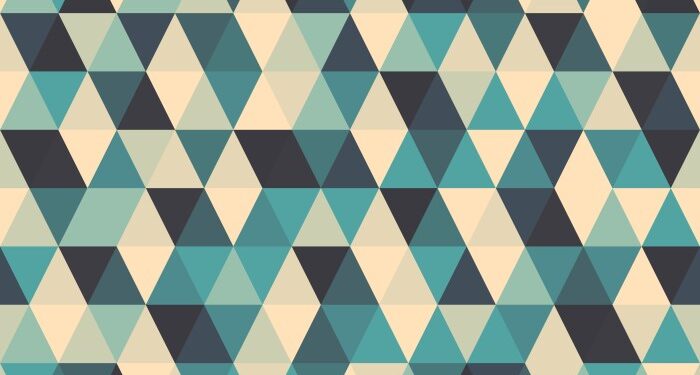Geometric patterns have long been a cornerstone in art, design, and architecture, captivating the eye with their intricate shapes and symmetrical beauty. As we delve into the realm of geometric patterns, a tapestry of history, creativity, and innovation unfolds before us, offering a deeper understanding of their impact on various aspects of our lives.
From the origins of geometric patterns to their modern-day applications, this exploration promises to enlighten and inspire, shedding light on the timeless allure of these mesmerizing designs.
Overview of Geometric Patterns
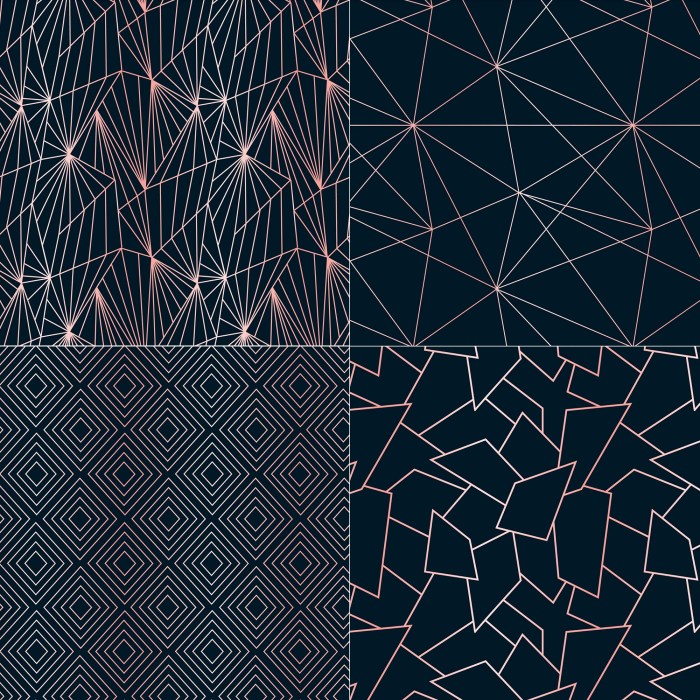
Geometric patterns are regular, repeating patterns that are created using geometric shapes such as circles, squares, triangles, and polygons. These patterns are characterized by their symmetry, balance, and precision.In art, geometric patterns have been used for centuries to create visually appealing designs that evoke a sense of order and harmony.
Artists often use geometric patterns to create intricate and complex compositions, adding a sense of structure and rhythm to their work.In design, geometric patterns are commonly used in textiles, wallpapers, and flooring to add interest and visual impact. These patterns can range from simple and minimalist to bold and vibrant, depending on the desired aesthetic.In architecture, geometric patterns play a crucial role in creating decorative elements such as tiles, mosaics, and facades.
These patterns can be found in historical buildings, modern skyscrapers, and everything in between, adding a touch of elegance and sophistication to the structures.
Examples of Common Uses of Geometric Patterns
- Islamic Art: Geometric patterns are a prominent feature in Islamic art and architecture, symbolizing unity, order, and infinity.
- M.C. Escher’s Artwork: The artist M.C. Escher is known for his intricate geometric patterns that play with perspective and optical illusions.
- Moroccan Tiles: Moroccan tiles are famous for their colorful geometric patterns that adorn walls, floors, and ceilings in traditional Moroccan architecture.
- Art Deco Design: The Art Deco movement of the 1920s and 1930s embraced geometric patterns in furniture, jewelry, and architecture, reflecting modernity and luxury.
Characteristics of Geometric Patterns
Geometric patterns are characterized by a variety of shapes, symmetry, repetition, and the use of colors to create visually appealing designs.
Types of Geometric Shapes
Geometric patterns can feature a wide range of shapes, including circles, squares, triangles, rectangles, hexagons, and more. These shapes can be arranged in intricate ways to form mesmerizing patterns.
Symmetry and Repetition
Symmetry is a key feature of geometric patterns, with elements being mirrored or repeated across a central axis. This repetition creates a sense of harmony and balance in the design, making it visually pleasing to the eye.
Use of Colors
Colors play a crucial role in enhancing geometric patterns. They can be used to highlight certain shapes, create depth and dimension, or evoke specific emotions. Bold and contrasting colors are often used to make geometric patterns stand out and grab attention.
History of Geometric Patterns
Geometric patterns have a rich history that spans various cultures and civilizations. These patterns have evolved over time and have been utilized in different art movements to create visually stunning pieces. Let’s delve into the origins and evolution of geometric patterns throughout history.
Ancient Civilizations and Geometric Patterns
Ancient civilizations such as the Egyptians, Greeks, and Romans were known for incorporating geometric patterns in their architecture, pottery, and textiles. These early civilizations used geometric shapes like circles, squares, and triangles to create intricate designs that held symbolic meanings.
Islamic Geometric Patterns
Islamic art is renowned for its intricate geometric patterns, which are often found in mosques, palaces, and manuscripts. These patterns, known as arabesques, feature a combination of geometric shapes and intricate designs that represent unity and infinity.
Renaissance and Geometric Patterns
During the Renaissance period, artists like Leonardo da Vinci and Albrecht Dürer explored geometric patterns in their works. The use of geometry in art became popular during this time, with artists incorporating mathematical principles and symmetry in their creations.
Modern Art Movements and Geometric Patterns
In the 20th century, geometric patterns experienced a resurgence in movements such as Cubism, Constructivism, and Op Art. Artists like Piet Mondrian and Bridget Riley used geometric shapes and patterns to create dynamic and visually engaging artworks that challenged traditional perceptions of art.
Creating Geometric Patterns
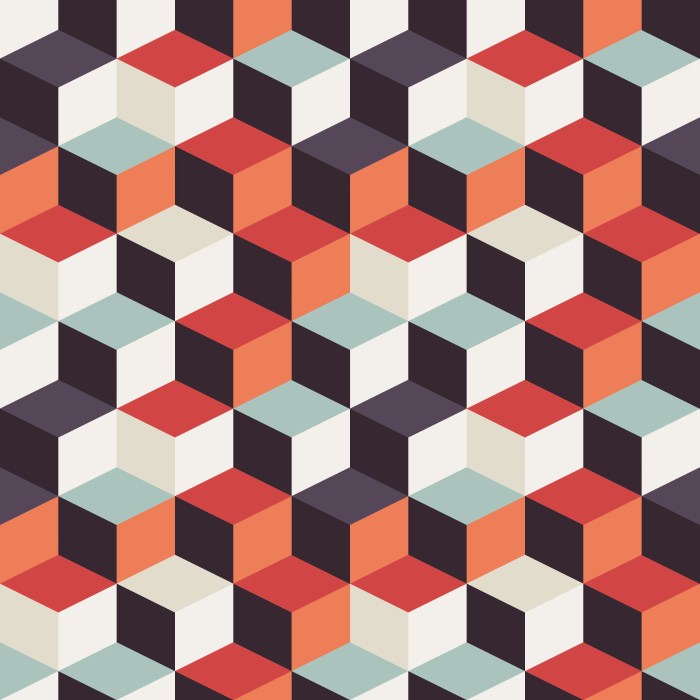
Creating geometric patterns involves a systematic process of designing and arranging geometric shapes in a visually appealing manner. Whether you are working on a simple design or a complex artwork, the key is to achieve balance and harmony in the final pattern.
Designing Geometric Patterns
To design geometric patterns, start by selecting the basic geometric shapes you want to work with, such as circles, squares, triangles, or hexagons. Experiment with different arrangements and orientations of these shapes to create interesting patterns. You can use tools like rulers, compasses, and protractors to ensure precision in your designs.
Constructing Geometric Shapes
When constructing geometric shapes in patterns, pay attention to the relationships between the shapes. Consider factors like symmetry, repetition, and scale to create a cohesive design. Experiment with different sizes, rotations, and reflections of the shapes to add depth and complexity to your patterns.
Combining Geometric Shapes
To combine geometric shapes effectively, consider overlapping shapes, interlocking shapes, or creating patterns within patterns. Experiment with different color schemes and textures to enhance the visual impact of your design. Remember to maintain a sense of balance and proportion throughout the pattern.
Achieving Balance and Harmony
Achieving balance and harmony in geometric pattern design is crucial for creating visually pleasing artwork. Pay attention to the distribution of shapes, colors, and negative space within the pattern. Strive for symmetry, rhythm, and unity to create a sense of cohesion in your design.
Regularly step back and assess your work to ensure that the elements are working together harmoniously.
Applications of Geometric Patterns
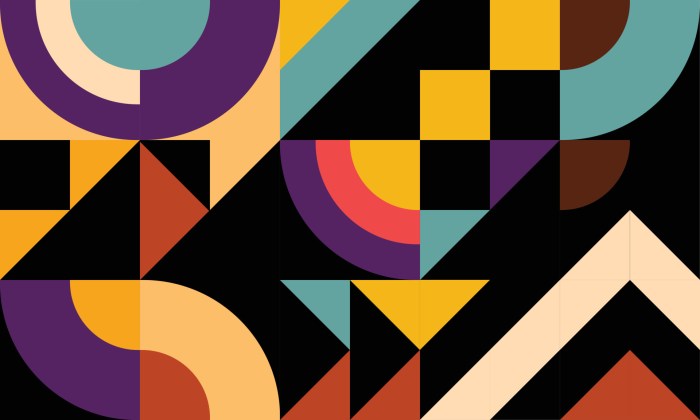
Geometric patterns are versatile and can be found in various applications such as interior design, fashion, textiles, and digital design and technology. Let’s explore how these patterns are utilized in each of these fields.
Interior Design
Geometric patterns play a crucial role in interior design by adding visual interest, depth, and character to a space. These patterns can be incorporated through wallpapers, rugs, tiles, and other decorative elements. For example, a room with a neutral color palette can be instantly transformed with the addition of geometric patterned throw pillows or a statement rug.
The use of geometric patterns in interior design can create a modern, sophisticated, or even playful ambiance depending on the chosen design.
Fashion and Textiles
In the world of fashion and textiles, geometric patterns are widely used to create eye-catching designs on clothing, accessories, and fabrics. From classic stripes and chevron to intricate tessellations and abstract shapes, geometric patterns can be seen on a variety of garments and accessories.
These patterns add a sense of structure, symmetry, and visual appeal to the designs, making them popular choices for both casual and high-fashion pieces.
Digital Design and Technology
Geometric patterns are also extensively applied in digital design and technology. From website backgrounds to user interface elements, geometric patterns are used to enhance the visual aesthetics of digital platforms. These patterns can create a sense of organization, hierarchy, and continuity in the design, making it more visually appealing and user-friendly.
Additionally, geometric patterns are often used in graphic design, branding, and digital art to create striking visuals that capture the audience’s attention.
Concluding Remarks
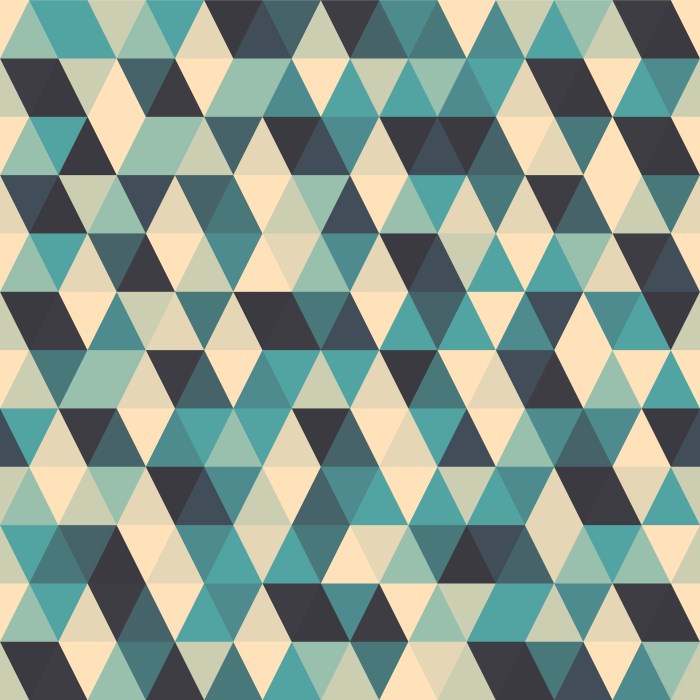
In conclusion, geometric patterns stand as a testament to the enduring power of precision and imagination in shaping our visual landscape. Whether adorning ancient temples or contemporary fashion pieces, these patterns continue to enrich our world with their boundless creativity and geometric charm.
FAQ Section
What are the different types of geometric shapes found in patterns?
Geometric patterns can feature shapes like circles, squares, triangles, hexagons, and more, each adding a unique element to the overall design.
How are colors used in geometric patterns to create visual impact?
Colors in geometric patterns are strategically chosen to enhance contrast, depth, and harmony, amplifying the overall visual appeal of the design.
Where are geometric patterns commonly used?
Geometric patterns can be found in architecture, textiles, digital design, and even nature, showcasing their versatile presence across various domains.

